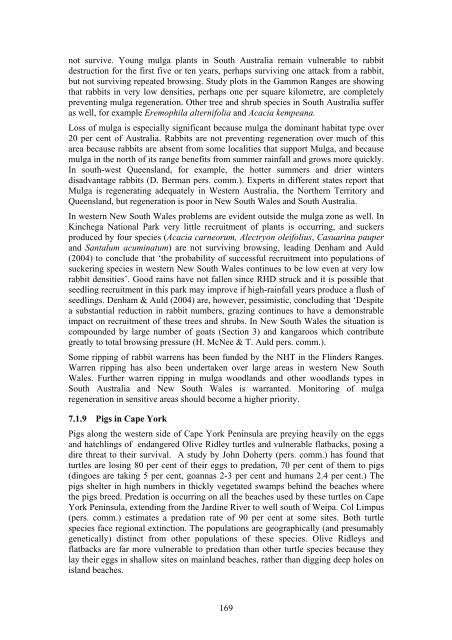Review of the management of feral animals and their impact on ...
Review of the management of feral animals and their impact on ...
Review of the management of feral animals and their impact on ...
You also want an ePaper? Increase the reach of your titles
YUMPU automatically turns print PDFs into web optimized ePapers that Google loves.
not survive. Young mulga plants in South Australia remain vulnerable to rabbit<br />
destructi<strong>on</strong> for <str<strong>on</strong>g>the</str<strong>on</strong>g> first five or ten years, perhaps surviving <strong>on</strong>e attack from a rabbit,<br />
but not surviving repeated browsing. Study plots in <str<strong>on</strong>g>the</str<strong>on</strong>g> Gamm<strong>on</strong> Ranges are showing<br />
that rabbits in very low densities, perhaps <strong>on</strong>e per square kilometre, are completely<br />
preventing mulga regenerati<strong>on</strong>. O<str<strong>on</strong>g>the</str<strong>on</strong>g>r tree <str<strong>on</strong>g>and</str<strong>on</strong>g> shrub species in South Australia suffer<br />
as well, for example Eremophila alternifolia <str<strong>on</strong>g>and</str<strong>on</strong>g> Acacia kempeana.<br />
Loss <str<strong>on</strong>g>of</str<strong>on</strong>g> mulga is especially significant because mulga <str<strong>on</strong>g>the</str<strong>on</strong>g> dominant habitat type over<br />
20 per cent <str<strong>on</strong>g>of</str<strong>on</strong>g> Australia. Rabbits are not preventing regenerati<strong>on</strong> over much <str<strong>on</strong>g>of</str<strong>on</strong>g> this<br />
area because rabbits are absent from some localities that support Mulga, <str<strong>on</strong>g>and</str<strong>on</strong>g> because<br />
mulga in <str<strong>on</strong>g>the</str<strong>on</strong>g> north <str<strong>on</strong>g>of</str<strong>on</strong>g> its range benefits from summer rainfall <str<strong>on</strong>g>and</str<strong>on</strong>g> grows more quickly.<br />
In south-west Queensl<str<strong>on</strong>g>and</str<strong>on</strong>g>, for example, <str<strong>on</strong>g>the</str<strong>on</strong>g> hotter summers <str<strong>on</strong>g>and</str<strong>on</strong>g> drier winters<br />
disadvantage rabbits (D. Berman pers. comm.). Experts in different states report that<br />
Mulga is regenerating adequately in Western Australia, <str<strong>on</strong>g>the</str<strong>on</strong>g> Nor<str<strong>on</strong>g>the</str<strong>on</strong>g>rn Territory <str<strong>on</strong>g>and</str<strong>on</strong>g><br />
Queensl<str<strong>on</strong>g>and</str<strong>on</strong>g>, but regenerati<strong>on</strong> is poor in New South Wales <str<strong>on</strong>g>and</str<strong>on</strong>g> South Australia.<br />
In western New South Wales problems are evident outside <str<strong>on</strong>g>the</str<strong>on</strong>g> mulga z<strong>on</strong>e as well. In<br />
Kinchega Nati<strong>on</strong>al Park very little recruitment <str<strong>on</strong>g>of</str<strong>on</strong>g> plants is occurring, <str<strong>on</strong>g>and</str<strong>on</strong>g> suckers<br />
produced by four species (Acacia carneorum, Alectry<strong>on</strong> oleifolius, Casuarina pauper<br />
<str<strong>on</strong>g>and</str<strong>on</strong>g> Santalum acuminatum) are not surviving browsing, leading Denham <str<strong>on</strong>g>and</str<strong>on</strong>g> Auld<br />
(2004) to c<strong>on</strong>clude that ‘<str<strong>on</strong>g>the</str<strong>on</strong>g> probability <str<strong>on</strong>g>of</str<strong>on</strong>g> successful recruitment into populati<strong>on</strong>s <str<strong>on</strong>g>of</str<strong>on</strong>g><br />
suckering species in western New South Wales c<strong>on</strong>tinues to be low even at very low<br />
rabbit densities’. Good rains have not fallen since RHD struck <str<strong>on</strong>g>and</str<strong>on</strong>g> it is possible that<br />
seedling recruitment in this park may improve if high-rainfall years produce a flush <str<strong>on</strong>g>of</str<strong>on</strong>g><br />
seedlings. Denham & Auld (2004) are, however, pessimistic, c<strong>on</strong>cluding that ‘Despite<br />
a substantial reducti<strong>on</strong> in rabbit numbers, grazing c<strong>on</strong>tinues to have a dem<strong>on</strong>strable<br />
<str<strong>on</strong>g>impact</str<strong>on</strong>g> <strong>on</strong> recruitment <str<strong>on</strong>g>of</str<strong>on</strong>g> <str<strong>on</strong>g>the</str<strong>on</strong>g>se trees <str<strong>on</strong>g>and</str<strong>on</strong>g> shrubs. In New South Wales <str<strong>on</strong>g>the</str<strong>on</strong>g> situati<strong>on</strong> is<br />
compounded by large number <str<strong>on</strong>g>of</str<strong>on</strong>g> goats (Secti<strong>on</strong> 3) <str<strong>on</strong>g>and</str<strong>on</strong>g> kangaroos which c<strong>on</strong>tribute<br />
greatly to total browsing pressure (H. McNee & T. Auld pers. comm.).<br />
Some ripping <str<strong>on</strong>g>of</str<strong>on</strong>g> rabbit warrens has been funded by <str<strong>on</strong>g>the</str<strong>on</strong>g> NHT in <str<strong>on</strong>g>the</str<strong>on</strong>g> Flinders Ranges.<br />
Warren ripping has also been undertaken over large areas in western New South<br />
Wales. Fur<str<strong>on</strong>g>the</str<strong>on</strong>g>r warren ripping in mulga woodl<str<strong>on</strong>g>and</str<strong>on</strong>g>s <str<strong>on</strong>g>and</str<strong>on</strong>g> o<str<strong>on</strong>g>the</str<strong>on</strong>g>r woodl<str<strong>on</strong>g>and</str<strong>on</strong>g>s types in<br />
South Australia <str<strong>on</strong>g>and</str<strong>on</strong>g> New South Wales is warranted. M<strong>on</strong>itoring <str<strong>on</strong>g>of</str<strong>on</strong>g> mulga<br />
regenerati<strong>on</strong> in sensitive areas should become a higher priority.<br />
7.1.9 Pigs in Cape York<br />
Pigs al<strong>on</strong>g <str<strong>on</strong>g>the</str<strong>on</strong>g> western side <str<strong>on</strong>g>of</str<strong>on</strong>g> Cape York Peninsula are preying heavily <strong>on</strong> <str<strong>on</strong>g>the</str<strong>on</strong>g> eggs<br />
<str<strong>on</strong>g>and</str<strong>on</strong>g> hatchlings <str<strong>on</strong>g>of</str<strong>on</strong>g> endangered Olive Ridley turtles <str<strong>on</strong>g>and</str<strong>on</strong>g> vulnerable flatbacks, posing a<br />
dire threat to <str<strong>on</strong>g>the</str<strong>on</strong>g>ir survival. A study by John Doherty (pers. comm.) has found that<br />
turtles are losing 80 per cent <str<strong>on</strong>g>of</str<strong>on</strong>g> <str<strong>on</strong>g>the</str<strong>on</strong>g>ir eggs to predati<strong>on</strong>, 70 per cent <str<strong>on</strong>g>of</str<strong>on</strong>g> <str<strong>on</strong>g>the</str<strong>on</strong>g>m to pigs<br />
(dingoes are taking 5 per cent, goannas 2-3 per cent <str<strong>on</strong>g>and</str<strong>on</strong>g> humans 2.4 per cent.) The<br />
pigs shelter in high numbers in thickly vegetated swamps behind <str<strong>on</strong>g>the</str<strong>on</strong>g> beaches where<br />
<str<strong>on</strong>g>the</str<strong>on</strong>g> pigs breed. Predati<strong>on</strong> is occurring <strong>on</strong> all <str<strong>on</strong>g>the</str<strong>on</strong>g> beaches used by <str<strong>on</strong>g>the</str<strong>on</strong>g>se turtles <strong>on</strong> Cape<br />
York Peninsula, extending from <str<strong>on</strong>g>the</str<strong>on</strong>g> Jardine River to well south <str<strong>on</strong>g>of</str<strong>on</strong>g> Weipa. Col Limpus<br />
(pers. comm.) estimates a predati<strong>on</strong> rate <str<strong>on</strong>g>of</str<strong>on</strong>g> 90 per cent at some sites. Both turtle<br />
species face regi<strong>on</strong>al extincti<strong>on</strong>. The populati<strong>on</strong>s are geographically (<str<strong>on</strong>g>and</str<strong>on</strong>g> presumably<br />
genetically) distinct from o<str<strong>on</strong>g>the</str<strong>on</strong>g>r populati<strong>on</strong>s <str<strong>on</strong>g>of</str<strong>on</strong>g> <str<strong>on</strong>g>the</str<strong>on</strong>g>se species. Olive Ridleys <str<strong>on</strong>g>and</str<strong>on</strong>g><br />
flatbacks are far more vulnerable to predati<strong>on</strong> than o<str<strong>on</strong>g>the</str<strong>on</strong>g>r turtle species because <str<strong>on</strong>g>the</str<strong>on</strong>g>y<br />
lay <str<strong>on</strong>g>the</str<strong>on</strong>g>ir eggs in shallow sites <strong>on</strong> mainl<str<strong>on</strong>g>and</str<strong>on</strong>g> beaches, ra<str<strong>on</strong>g>the</str<strong>on</strong>g>r than digging deep holes <strong>on</strong><br />
isl<str<strong>on</strong>g>and</str<strong>on</strong>g> beaches.<br />
169
















